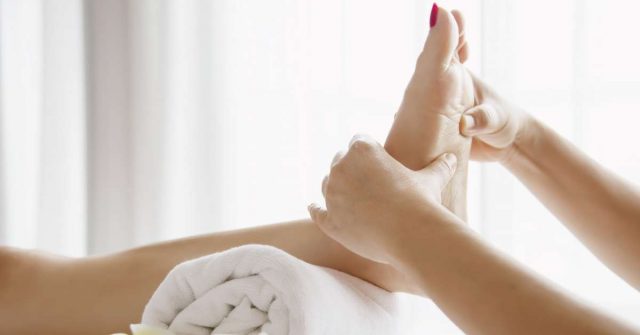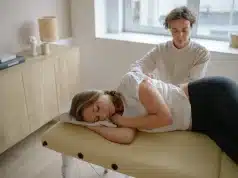If you want to feel better and ease the accumulated stress from your busy and hectic lives, you can use a specific kind of therapy, reflexology. It is a form of massage as reflexologists use their hands and apply pressure on feet, hands, or ears to ease your stress.
It is not typical care, and this Chinese foot massage cannot treat or diagnose any illness, but it can be used as a complementary treatment to some medical ones. It is an antient Asian healing practice based on the principles of connection between different body parts and reflex points of the feet.
Everyone loves a foot massage and feels better after having it. So, let’s learn why this type of massage is worth trying.
How Does Foot Reflexology Work?
Reflexology is a holistic practice that can improve the quality of your life in different ways. It is a mainstay of traditional Chinese medicine.
It has been here for centuries, and it has been practiced since 2300 B.C.
It is a zone and an alternative therapy that involves applying pressure to the feet without any oil and lotion. When applied, it improves your body’s nerve response, gives you balanced energy levels, and improves your blood circulation.
Understanding The Foot Reflexology Chart
Can you imagine your whole body projected on your foot? This is what basically the reflexology chart is.
The left foot will stimulate the left side of your body, while the right foot will stimulate the right side.
So, how are some parts of the feet connected to your body parts?
To give an example, the bottom of your feet, from the tip to the heel, is related to your spine. The second and the third toe relate to your eyes, while the other toes are connected to your teeth, head, and sinuses.
Here is an example of a reflexology foot chart so you can see the reflexology points on your feet:
Modern science needs more quality and thorough research to confirm how this Asian therapy works.
Some studies confirmed that it could be beneficial for reducing back pain, lowering migraine pains, and reducing stress. (1) (2)
Reflexology Benefits
But, this doesn’t mean that it is not beneficial for many uses, and one of the key benefits of this therapy include:
1. Stress and relaxation (One of the main benefits of this massage as by increasing the blood flow in your body, your stress level is decreased).
2. Pain management ( It can help you with acute and chronic pain. In one 2019 study, it was proved to be effective with children that had chronic pain and reduced it significantly.) (3)
3. Digestion ( The reflexology helps digestion by increasing the blood flow, but more research is needed to confirm this statement.)
4. Eyestrain ( Our daily activities include looking at screens all day long, and reflexology may help with relaxing the tight muscles around our eyes.)
5. Improved sleep ( After a reflexology treatment, you can easily get a good night’s sleep as it reduces the stress and relaxes your muscles.)
6. An overall sense of well–being and clearing your body from the accumulated toxins.
In addition to this, it can:
- Fight cancer
- Resolve sinus issues
- Improve fertility
- Improve immune system
- Help you with back problems
- Fight colds and bacterial infections
- Correct hormonal imbalances
- Release arthritis pain
- Treat nerve problems and numbness from cancer drugs (peripheral neuropathy)
Difference Between Reflexology And The Foot Massage
Reflexology is done mainly on the feet and involves small muscle movements compared to the common massage that can be done on every part of the body and involves large muscle movements.
Reflexology derives from antient Asian cultures. This massage stimulates the complex pathways that wind throughout the body and doesn’t simply interact with the feet’ soft tissues. The reflexologist applies different techniques to treat reflex points that connect feet to different body parts like organs, bones, or body systems. There are numerous reflex points on the feet that can be stimulated to induce healing and lead to balance in the whole body.
This massage has more health benefits compared to the ordinary foot massage that is limited to the feet only.
Foot massage is used for sore and tense feet to relieve the pain, and it is used for stimulating and improving circulation. When your blood flow is improved, it will reduce the tension and promotes healing. You can do a foot massage by yourself or ask someone to do it for you.
A simple foot massage will be kneading stiff or sore areas of your feet with the help of your hands and knuckles. At the same time, you can spread the toes apart to stretch the muscles.
4 Reasons Why Reflexology Can Be Painful
There could be several reasons why your foot hurts while you are having a massage. In fact, there are around 200.000 nerve endings on your feet, so if you haven’t had any foot massage before, it might cause you some weird sensations.
Here is the list of the main reasons why you experienced pain during the foot massage:
1. Because your feet have never been massaged before
Most people have probably had a rare chance of having a foot massage, so pain and discomfort might be part of your first ever foot massage, but do not worry, with time and as you continue to get more massages, the pain is lower, and it will eventually go away.
2. Maybe you have some health issues
If you experience some pain during reflexology, it might be that something else is going on in your body or something is wrong with that particular part of the body. This may indicate that you should pay a visit to your family doctor and do some tests to see if you are in good shape.
In Chinese Reflexology, when some painful point is found, the therapist focuses on it, while in the Western world, is completely different, and the therapist tries to ease the movements and the massage to ease the pain.
3. Your masseuse is applying too much pressure
There are, unfortunately, many poorly trained therapists, and if you end up with this type of therapist, you may feel pain, so it is very important to find the right therapist and try out as many therapists as you can and see what works best for you.
4. Because some congested reflex areas are treated
Reflexology doesn’t resemble a foot massage, and you will usually feel the pain when some congested reflex areas are massaged, but the soreness will go away in a few sessions.
In the end, if the pain is intolerable, it is not wrong to ask the therapist to stop the massage.
How Can You Practice Reflexology By Yourself?
As mentioned above, reflexology is a treatment that takes into account all aspects of a person and has no known side effects, except for some mild ones.
How does it work?
Your hands and feet provide a map of your body’s organs, and just a small gentle pressure may give indirect access to areas in need.
Besides many health benefits stated above, reflexology may also act as a preventive measure to keep your body balanced. This traditional Chinese foot massage creates equilibrium within yourself since it believes that all diseases are caused by some sort of imbalance or vital energy, known in Chinese medicine as QI.
Although it is recommended to see a professional reflexologist for better results and safety or book a reflexologist near you, you can do some easy reflexology techniques at home by yourself to ease pains such as:
- back-aches
- headaches
- general stress and tension
For some step-to-step guide on foot reflexology, you can consult a trained reflexologist or try to practice applying pressure on some reflex points on your feet by yourself and use your hands and thumbs to gently work the area for several minutes.
We offer you a few examples of different pain relief massage techniques that you can practice at home.
Menstrual cramps
If you have menstrual cramps and painful periods, you can use Reflexology to ease the pain. You should try it with mild pressure on both sides of your heels, where the uterus and ovary reflexes are situated.
Stress relief and headaches
There are some specific points on your feet that can ease stress tensions, so to relax this important part of your brain, make some gentle pressure over the tips of your toes and right inside your foot. To ease a headache, try squeezing your big toes and if it is caused by your sinuses, try some pressure on the other toes as well.
Teething pains
If your baby is having some teething problems, gently pressure the web of their hands between the thumb and forefinger to soothe the teething pains.
Stomach aches
If you have some stomach aches, you need to massage your left foot as this is the place where all the reflexology pressure points related to this body part are situated. In this case, you can apply some gentle pressure to the outside of the arch of your foot, next to the heel.
Note: Avoid these pressure points when pregnant, as they might stimulate the uterus.
How Reflexology Can Help Plantar Fasciitis?
Plantar fasciitis is usually experienced as stabbing heel pain and stiffness when you walk out of bed early in the morning.
It can cause mild discomfort or sometimes debilitating pain and affects around 2 million Americans each year. It is caused by inflammation of one thin ligament that runs across the bottom of your foot. This ligament is the foot’s arch that supports your leg while you walk. It can found usually in runners, and you may have a risk of getting it if you are overweight, menopausal, pregnant, or wear shoes with inadequate support.
Reflexology may be beneficial as it can relieve some pain, and it can use pressure points techniques to release tensions in the feet.
Reflexology is a better and healthier remedy than Plantar fasciitis surgery. Similar to another massage, this therapy doesn’t give an instant cure, but with regular reflexology sessions, you can achieve an improvement and you will experience gradual pain relief on a daily basis.
When your legs are soaked in warm salt soak, the reflexologist will start the massage by losing up the tight bands of the fascia, stretching the ligaments, and breaking up the crystals in your legs to reduce the inflammation and ease the pain.
Reflexology Side Effects
If you are pregnant, you should inform your therapist because some pressure points may induce contractions.
Some people have also reported some mild side effects as:
- Emotional sensitivity
- Mild headaches
- Sore feet

Ana Miller is a creative writer. Her topics of interest and expertise range from psychology to all sorts of disciplines such as science and news.





